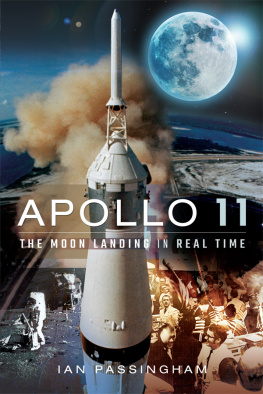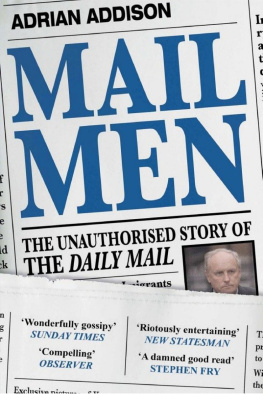Pagebreaks of the print version

APOLLO 11
THE MOON LANDING IN REAL TIME
APOLLO 11
THE MOON LANDING IN REAL TIME
IAN PASSINGHAM

First published in Great Britain in 2019 by
PEN AND SWORD HISTORY
An imprint of Pen & Sword Books Ltd Yorkshire Philadelphia
Copyright Ian Passingham, 2019
Hardback ISBN 978 1 52674 856 0
Paperback ISBN 978 1 52675 761 6
eISBN 978 1 52674 857 7
Mobi ISBN 978 1 52674 858 4
The right of Ian Passingham to be identified as Author of this work has been asserted by him in accordance with the Copyright, Designs and Patents Act 1988.
A CIP catalogue record for this book is available from the British Library.
All rights reserved. No part of this book may be reproduced or transmitted in any form or by any means, electronic or mechanical including photocopying, recording or by any information storage and retrieval system, without permission from the Publisher in writing.
Pen & Sword Books Limited incorporates the imprints of Atlas, Archaeology, Aviation, Discovery, Family History, Fiction, History, Maritime, Military, Military Classics, Politics, Select, Transport, True Crime, Air World, Frontline Publishing, Leo Cooper, Remember When, Seaforth Publishing, The Praetorian Press, Wharncliffe Local History, Wharncliffe Transport, Wharncliffe True Crime and White Owl.
For a complete list of Pen & Sword titles please contact
PEN & SWORD BOOKS LIMITED
47 Church Street, Barnsley, South Yorkshire, S70 2AS, England
E-mail:
Website: www.pen-and-sword.co.uk
Or
PEN AND SWORD BOOKS
1950 Lawrence Rd, Havertown, PA 19083, USA
E-mail:
Website: www.penandswordbooks.com
INTRODUCTION
Two men walking on the Moon. Back in 1969 it seemed like something from a science fiction novel. In many ways it still does. Half a century on, the first lunar landing is still regarded by many conspiracy theorists excepted, of course as the greatest feat of the twentieth century. And yet, while Apollo 11 will always command a unique place in the history books, it is difficult today to grasp what it meant at the time; how dangerous it was, how much excitement it generated, and how divisive it was.
The mission attracted unprecedented worldwide interest. However, at a time when the USA was grappling with troubles at home and abroad, Apollo 11 polarised opinions. Supporters marvelled at the courage of the astronauts and the remarkable technological advances which made the mission possible. NASA argued that Apollo 11 would benefit all mankind and that even more exciting space adventures would soon follow. Opponents complained that the Moon shot was a waste of money driven by Cold War politics and that the United States should be ashamed of its mixed-up priorities.
It was against this backdrop of unbridled enthusiasm and optimism mixed with bitter controversy that Neil Armstrong, Buzz Aldrin and Michael Collins set off on their historic adventure. So, while this book is the story of man on the Moon, it is also the story of man on Earth in July 1969; a story told not from a twenty-first century perspective, but as it was at the time. It was a time when NASA spoke of landing men on Mars in the 1980s and the US President predicted we would discover life on other planets by the year 2000, when Cold War paranoia meant many Americans feared the Soviet Union might launch an attack from space, and when protestors marched on Cape Kennedy on the eve of the launch demanding action over hunger and poverty. It was a time when the speed of technological advances contrasted starkly with a society in which the First Lady wasnt allowed to watch splashdown because archaic Navy rules barred women from its ships during major operations, and when many African Americans turned their backs on what they regarded as a white mission.
Apollo 11 was mans greatest adventure; an epic 500,000-mile return journey into the unknown. We know how the story ends, but there are many surprises along the way.
CHAPTER 1
RACE TO THE MOON 195769
Let the capitalist countries try to catch up with our country, which has blazed a trail into space.
Soviet Premier Nikita Khrushchev, 1961
It wont be one man going to the Moon, it will be an entire nationfor all of us must work to put him there.
US President John F. Kennedy, 1961

John F. Kennedy addresses Congress and sets the USA the goal of landing on the Moon by the end of the 1960s.
RED MOON SHOCK
4 OCTOBER 1957
The Soviet Union stunned the world today when it launched the first man-made satellite to orbit Earth.
Soviet space scientist Professor Kiril Stanikovich hailed it a great event for all mankind, but in the USA it has sparked fears that the Communist superpower might launch an attack from space.
Henry Jackson, chairman of the Senate sub-committee for Military Applications of Atomic Energy, said the Red Moon was a devastating blow and a stepping-up of the Cold War.
Major General Holgar Nelson Toftoy, Commander of the Armys Redstone Arsenal in Alabama, claimed that his team, led by former Nazi rocket genius Doctor Wernher Von Braun, could already have put a satellite in orbit had a Navy project not been given priority. Toftoy said: We said we could do it and, by God, we could. But we were told this wasnt a race.
DOG IN SPACE
3 NOVEMBER 1957
A dog called Laika today became the first live animal in space as the Soviets launched a second successful satellite.
Ivan Alexanderson, Moscow Radio chief, said: The chief purpose of the project is to prove mans ability to navigate and live in space. The Soviets said medical data showed the dog was in good condition. However, it is understood theres no way of returning it to Earth.
KAPUTNIK SHAMBLES
6 DECEMBER 1957
America was left red-faced today when an attempt to launch its first satellite ended in a spectacular live TV failure.
President Dwight Eisenhower has demanded a full report after the Navy-designed Vanguard rocket rose just 4ft at Cape Canaveral, Florida, before exploding. It has been branded Kaputnik and Senate Majority Leader Lyndon Johnson said: Its one of the most humiliating failures in our history.
AMERICA UP AND AWAY
31 JANUARY 1958
The USA finally has a satellite in orbit after todays successful Explorer 1 launch.
Although the 30lb satellite, tiny in comparison to the Soviet Sputniks, was fired into space on a Juno rocket, a modified version of a Jupiter-C designed by the Army, Vice President Richard Nixon said the USA was committed to space exploration in the cause of peace.
NEW SPACE AGENCY
1 OCTOBER 1958
A new civilian agency has taken over responsibility for Americas space programme.
The National Aeronautics and Space Administration (NASA) came into being today under legislation signed in July by President Dwight Eisenhower. The National Advisory Committee for Aeronautics (NACA) has been absorbed into NASA, along with some Army and Navy staff and facilities.
ASTRONAUTS UNVEILED
9 APRIL 1959
NASA has named seven test pilots as its first team of astronauts.













